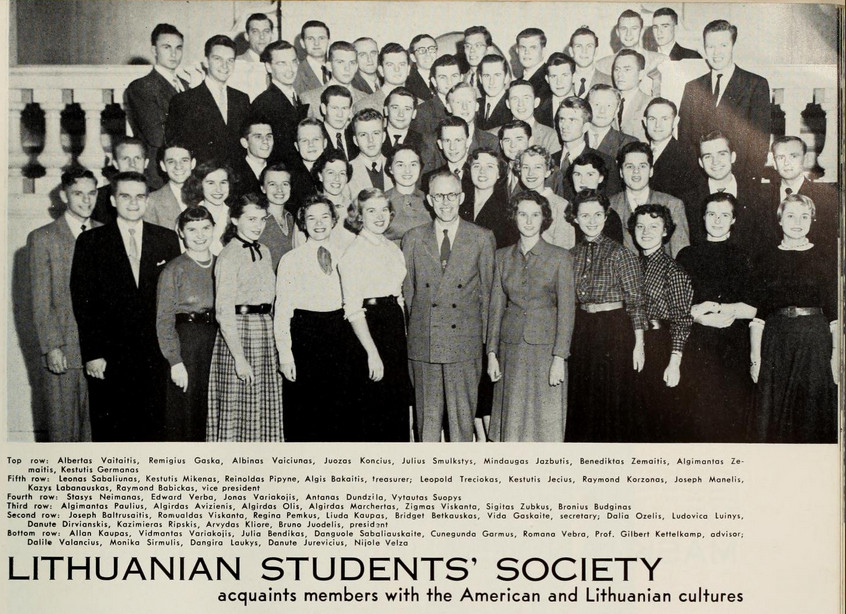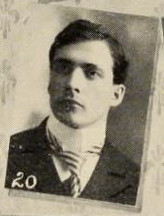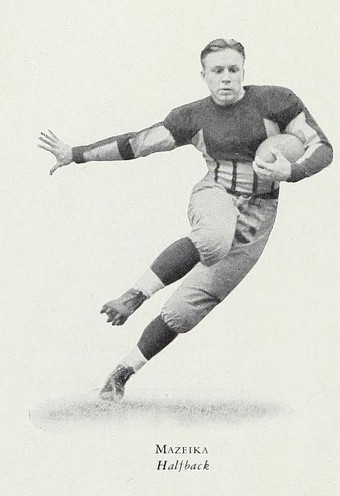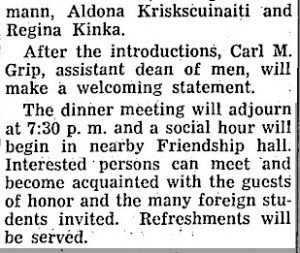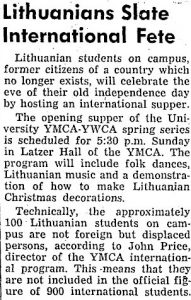Since at least 1897, Lithuanian students have been a part of the University of Illinois. Lithuanian Illini have included baseball players, basketball players, electrical engineers, football players, journalists, liberal arts majors, library catalogers, mechanical engineers, military officers, swimmers, and teachers. Read on to learn more about early Lithuanian Illini!
- A 1955 Illio group photo of the new Lithuanian Students’ Society, found in Record Series 41/8/805.
Pre-Indepedent Lithuania
Stanislav Dowiatt
One of the first Lithuanian students may have been Stanislav Dowiatt (B.S. in Mechanical Engineering, 1900). Mr. Dowiatt left Kovno, Kovno Governate, Russian Empire, (now Kaunas, Lithuania) for Chicago, where he attended high school and later worked as a cataloger in the Chicago Public Library, until his enrollment at the University. Mr. Dowiatt left limited student life records, leaving his student days as a mystery beyond his bachelors thesis and a listing as a member of the Civil Engineering Club. After graduation, Mr. Dowiatt found employment in Pennsylvania, then Spokane, Washington, and later in California where he worked in the oil industry. [1][2]
- Stanislav Dowiatt Illio Photo from the 1900 Illio, Page 35, found in Record Series 41/8/805.
- Stanislav Dowiatt graduation information from the 1901 Illio, Page 52, found in Record Series 41/8/805. (Note: The caption generalizes Kaunas’ location in Poland, while the Kovno Governate of the Russian Empire is more accurate.)
Ausra Society of Chicago Scholarships
Shortly after Mr. Dowiatt’s graduation, the Aušra (“dawn” or “aurora”) Society of Chicago formed to sponsor Lithuanian students interested in studying the arts and returning to Lithuania to build the nation. [3] However, in the case that all artists were supported, then secular fields of study were considered by the scholarship committee. [4] For the next few decades, the Aušra Society sponsored many Lithuanian students to attend schools like the University of Illinois. In ten years time, in 1912, the organization expanded to include its own school and library.
Vincent Miseika
One scholarship student, Vincent Mišeika, of Linkuva, came to Illinois where he studied mechanical engineering for six months without completing a degree. [5] Prior to studying in Illinois, Mr. Mišeika studied at the Institute of Technology in Riga, Latvia. In 1902, he arrived in Chicago after one and a half years of work in Waterbury, Connecticut. At the age of 34, Mr. Mišeika was persuaded to return to school and study engineering at Illinois. Upon returning to Chicago, Mr. Mišeika found employment at the Aušra Society school for ten years, before joining the Lithuanian newspaper staff Naujienos and becoming a real estate agent in Chicago.
Independent Lithuania
The Stulginskis Family
The Stulginskis family lived in Westville, Illinois, about 36 miles east of the University of Illinois. Jonas Stulginskis left Lithuania for Illinois in the late 1890s, while his brother Aleksandras remained and later became the second president of Lithuania. Two children came to Illinois to study
- A 1925 Illio profile photo of Bruce Stulginskis, found in Record Series 41/8/805.
Bronislovas “Bruce” Alexander Stulginskis (B.S. in Electrical Engineering, 1924) was an active sports player when not studying. Daily Illini articles announce a basketball-related injury during his freshman year and his later enrollment in a ping pong tournament during his sophomore year. [6] While enrolled at Illinois, Mr. Stulginskis’ father passed away. In fact, the local newspapers reported that Mr. Stulginskis’ uncle, recently elected Lithuanian president Aleksandras Stulginskis, remotely arranged his son’s education, with the intention to send Bruce to Berlin for graduate study. [7]
- A 1929 Illio profile photo of Marcella Stulginskis, found in Record Series 41/8/805.
Marcella Martina Stulginskis (B.A. Liberal Arts and Sciences, 1928) was active in women’s education issues on campus. She was a member of the women’s group Achaea, a member of the multinational Women’s Cosmopolitan Club, and a chair of the freshman education committee. [8] During Ms. Stulginskis’ junior year, her uncle retired from Lithuanian politics. After graduation, she relocated to Chicago.
Lithuanian University Club of Chicago Scholarship
In 1936, the Lithuanian University Club of Chicago announced a full tuition scholarship for one University of Illinois student. The requirements included: the applicant must be of Lithuanian descent, the applicant must live in Cook County, the applicant must be a junior or senior, and the applicant must have a fair grade point average as well as a financial need. [9]
Anthony M. Mazeika
Anthony “Cy” M. Mažeika, was a halfback on the football team under Coach Robert Zuppke and a center fielder on the baseball team too. An active member of Tribe of Illini, Mr. Mažeika was elected sergeant-at-arms in 1937. [10] Known for his speed on the field and his sense of good humor, a great many Daily llini articles provide quotes and anecdotes of Mr. Mažeika’s time on campus. Following graduation, Mr. Mažeika enlisted in the military where he served a long career of service. [11]
- A 1937 Illio sports profile photo of Anthony Mazeika, found in Record Series 41/8/805.
- A 1939 Illio sports profile photo of Anthony Mazeika, found in Record Series 41/8/805.
Displaced Persons
Like some Latvian and Ukrainian Illini, some Lithuanian Illini were unable to return to their country of origin during and following World War Two. Indeed, during World War Two, Europeans like Aleksandras Stulginskis (Bruce and Marcella’s uncle) were deported to Siberian labor camps by the occupational Soviet government in 1941. Following the war, some students lived in displaced persons campus until they were relocated to another country. Among other students, at least two Lithuanian students came to the University of Illinois: Regina Trinka and Aldona Kriksciunaite. Multiple members of the University community provided resources for the foreign students. The Board of Trustees provided tuition scholarships, fraternities and sororities provided housing, while local religious organizations and student groups provided welcome celebrations to help new students acclimate to their new home.
- A Daily Illini article announcing the arrival of some displaced persons to campus, found in Record Series 41/8/802.
- A Daily Illini article announcing the arrival of some displaced persons to campus, found in Record Series 41/8/802.
- A Daily Illini article announcing a welcome reception for the displaced persons on campus, found in Record Series 41/8/802.
- A Daily Illini article announcing a welcome reception for the displaced persons on campus, found in Record Series 41/8/802.
As early as 1953, the Lithuanian Students’ Society formed as the first Lithuanian cultural organizations on campus with Education Professor Gilbert Kettelkamp (Education, PhD, 1941) as faculty advisor. Their purpose was:
To represent Lithuanian students and culture in the social and cultural events at the University of Illinois, to encourage cultural and social activities through which its members will be acquainted with American students and the cultural, social, and political life of the United States. [12]
From 1951-1952, the LSS organized a Lithuanian Night at the University YMCA, a Get-Acquainted Party for Estonian, Latvian, and Lithuanian students, a campus lecture by Dr. Steponas Kolupaila, [13] In 1955, a local Lithuanian art show at the Illini union was organized to feature Lithuanian student art from the Art Institute of Chicago. [14] For years, Lithuanian student editorials can be found in the pages of The Daily Illini which richly document Lithuanian Illini perspectives of current events in Lithuania and they annually celebrated the declaration of independence of Lithuania on February 16, 1918. The LSS was in existence from 1951 until 1969 and again from 1972 until 1974.
- A Daily Illini article describing a Lithuanian Meal hosted by the YWCA and YMCA, found in Record Series 41/8/802.
- A Daily Illini article describing a Lithuanian student response to Siberian deportations in Lithuania, found in Record Series 41/8/802.
- A Daily Illini article describing a large Lithuanian event on campus, found in Record Series 41/8/802.
After decades of Lithuanian student organizing, it was 1984 when the Endowed Chair of Lithuanian Studies was created at the University of Illinois at Chicago campus where it recently celebrated its thirtieth anniversary. [15] Today, Lithuanian studies are further supported by a tuition scholarship for UIC students and a separate competitive Dr. Kazys Grinius Endowment Scholarship of which all University of Illinois systems students are eligible. Further research into Lithuanian studies is supplemented by the great Lithuanian library collections at both the University of Illinois campuses at Chicago and Urbana-Champaign.
For over one hundred years, Lithuanian Illini have come to the University of Illinois supported by generous scholarships created by Lithuanians before them. Lithuanian Illini have distinguished themselves as athletes, as scholars, and as activists. Indeed, as engaged students in campus life and enthusiastic supporters of future scholars, Lithuanian Illini have grandly contributed to making Illinois feel like a second home.
Are you a Lithuanian Illini? Do you know someone who is? We’d like to hear from you! Please send us a message or leave a comment below. We want to include you and your story, as we celebrate the first 150 years of the University of Illinois.
Happy First 150 everyone!
(A special thank you to the 2015-2016 University of Illinois Slavic Graduate Student Association and Dr. David Cooper who gave feedback on an early version of this work.)
[1] Alumni Quarterly, Volume 1, Number 1, January 1907, page 46 and Alumni Record, 1918, page 129.
[2] “Lithuanian Graduated in Engineering Course“, Lietuva, Vol. VIII, No. 26, June 29, 1900.
[3] The organization attempted to provide generous annual scholarships to accepted students. Please see: “The Aurora Society“, Lietuva, Vol. X, No. 8, February 7, 1902.
[4] “By-Laws of the Aurora Society“, Lietuva, March 28, 1902.
[5] “Data Supplied by Alex Ambrose of the F.L.P. (Foreign Language Press Survey): Vincent Miseika, 1748 W. 86th St., Chicago“, August 30, 1937.
[6] Mr. Stulginskis suffered a kidney injury during a basketball game. Five days later, it was reported that he was recovering. “Stulginskis’ Condition Unchanged”, The Daily Illini, March 10, 1922, Page 1; “Health Situation Is Above Normal–Beard”, The Daily Illini, March 15, 1922; “Ping Pong Tourney at ‘Y’ Attracts 18”, December 23, 1922, Page 5.
[7] In 1923, an Associated Press interview with Bruce Stulginskis was run in multiple newspapers papers across the country. One Illinois example includes: “Youth Studies here for Life Work in Lithuania”, The Daily Free Press, Carbondale, Illinois, August 29, 1923, Page 2.
[8] “Women’s Groups Elect Officers”, October 14, 1927, Page 11.
[9] “Scholarship Given by Lithuanian Club”, June 20, 1936, Page 4.
[10] “The 5th Estate”, October 1,5 1937, Page 6. For a broader scope of his career, please see the over 200 Daily Illini articles citing athletic performances of Mr. Mazeika. For a quote about his good feelings towards Coach Zuppke, please see: “Players Approve Action of Board on Resignation”, November 30, 1938, Page 6.
[11] Of course, there have been many Lithuanian Illini athletes since Mr. Mazeika. For example, Mr. Richard Butkus has a long distinguished career in football. Please see Richard Butkus Papers, Record Series 26/20/102.
[12] “Lithuanian Students Society”, Record Series 41/2/41, Box 16.
[13] Ibid.
[14] “Young Lithuanian Artists Exhibit Shows Oils, Woodcuts, Lithographs”, The Daily Illini, November 8, 1955, Page 6.
[15] The UIC University Archives does have some student records for their local Lithuanian student population. During the Navy Pier years, please see the Lituanica Club found in the “Student Organization Records 1946-65” (Record Series 59/3/2). During the UIC years, please see the Lithuanian Student Association found in the “Student Life – Flyers, Handbills and Brochures” (Record Series 59/7/12).

